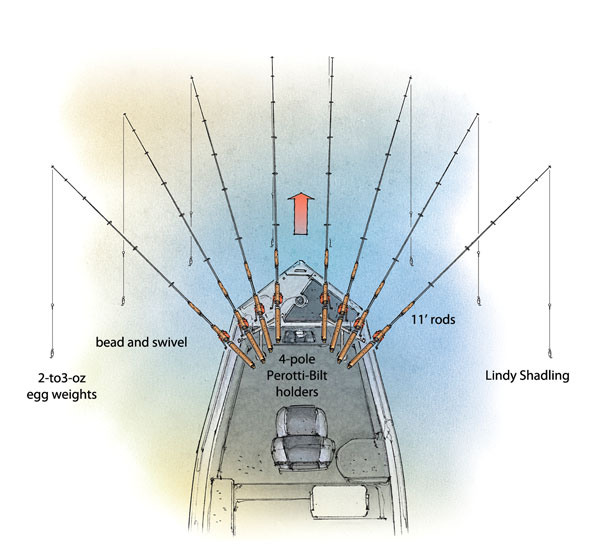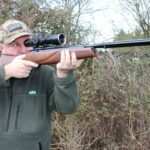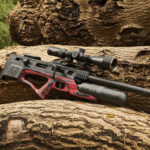
Spider Rigging For Crappie
Spider rigging for crappie looks simple enough — a bunch of fishing rods weaving a web of lines from bow to stern. A closer look at the boats of crappie pros reveals that their spider rigs are intricate systems based on exact rod positioning and specialized rod-holder designs. The pros set up their spider rigs differently depending on the situation, whether it’s fishing deep brushpiles, open-water structure, shallow vegetation, or for pushing crankbaits.
The most essential pieces of equipment for spider-rigging are the rods and holders. “The key is to make sure the rods are all the same,” says Barry Morrow, a guide on Oklahoma’s Lake Eufaula. “All the rods should be the same length, power, and action, and they should be adjusted to the same height in the rod holders, so that you are able to decipher the motion of the rod tips to detect bites. If you are using different types of rods they’re all bowed differently and respond differently to strikes, making it more difficult to interpret rod-tip and line movement.”
Preferences on rod-holder design vary among the pros, but there’s one that top anglers all agree on: Rod holders need to be stable. “When I mount a set of rod racks, I want those things not to move,” says Alabama guide Brad Whitehead. Beyond that, top spider-riggers have developed individualized setups to suit the situations they fish.
Probing deep brush
For spider-rigging over brushpiles on Wilson and Pickwick lakes, Whitehead prefers 12-foot rods at the bow. He places 10-foot rods across the stern for his clients because the shorter rods are easier for them to handle. Rods are spread evenly across the bow and stern for uniform coverage and easy access to the poles. “I’m a fanatic on keeping 11„2 feet between each rod,” says Whitehead, who also keeps each rod tip about 8 to 10 inches above the water.
He usually sets his baits at different depths, varying about 1 to 2 feet. “I want my shallowest rods to my right and left, but the deepest rods are always the two in the middle,” he says. His poles are rigged with B’n’M Capps and Coleman Minnow Rigs (with a 1-ounce weight).
Whitehead’s choice of rod holder is a four-pole Hi-Tek Stuff mount. He positions two of the mounts about 3 feet apart on the bow and stern. “Position rod racks so when you are sitting, you don’t hit your knees on the rod handles,” he says. “Make sure they’re far enough away, but not too far to where you have to bend to get the rods. You want to be able to sit up straight when you grab rods.”
Pad fishing
Six-time national champions Ronnie Capps and Steve Coleman are renowned for their spider-rigging tactics in the lily pad stems at Reelfoot Lake. The key to their setup is a customized pole-holder system with independent mounts rather than a rack that holds multiple rods. “The rod holders cradle the poles so you have no trouble getting your hand between the forks of the holder and the rod butt. And when you grab a pole out of the holder it’s a quick reaction,” says Capps. “You’re able to get your hand in there with no problem.
“The reason for the independent holders is because I want my poles to be ultra still. With a T-bar type mount, on the other hand, if you grab one pole from a set of four, you disturb the other three rods and you can’t detect a bite. With independent holders, you can detect bites well. I also think fish bite better when a pole isn’t moving much.
Capps is constantly moving his poles off the pad stems to prevent hang-ups. He says the individually mounted holders are critical in this situation because getting hung up on one pole doesn’t disturb the others.
The Tennessee pro also prefers a rod holder with a Y-fork cradle rather than a U-shaped cradle, for better hook-sets. “If you see a bite and the line is scooting to the left, you want to set the hook to the right. But with some of the U-shaped holders there is only one way to get that pole out — straight up,” Capps says.
The depth and cover Capps fishes determines how far apart he positions 8 poles across the front of the boat. “If I’m fishing shallow and directly into spots that I expect fish to be in, I bunch poles tight,” he says. “If I’m trying to cover more area on a shallow flat, I set them farther apart.”
For pushing a single 1/16-ounce jig on 6-pound line in the lily pads, Capps uses 16-foot B’n’M jig poles (model BGJP163). “I get more bites having my baits farther from me with 16-foot poles than I do with 14-footers,” he says, also noting that 16-footers allow him to cover a wider swath of water. Extra length also keeps his jigs farther from the boat, away from trolling motor noise that could spook shallow fish.
Riprap and breakline trolling
Oklahoma guide and tournament competitor Todd Huckabee prefers single-pole fishing whenever possible. But there are certain conditions when he resorts to spider-rigging, such as during the postspawn on his home waters of Lake Eufaula when crappies pull off the bank and suspend 2 to 6 feet deep over riprap and breaklines in the depth range of 10 to 15 feet.
Four-rod Perotti-Bilt rod holders are Huckabee’s choices for spider-rigging. “They are simple and sturdy,” he says. “When a fish hammers one pole, the other three don’t shake — you can tell which pole got the bite.” He mounts his rod holders on each side of the boat’s bow, positioning the rods about 2 feet off the floor. “I want rods set where I can reach over and set the hook quickly, without having to bend over too far,” he says.
His choices for spider-rigging poles are 11-footers with plenty of backbone. “When I get bit I can pull the fish up with that pole in between all the other poles.” he says. Huckabee sometimes varies his presentation between minnow rigs and tandem-jig rigs, but most of the time he spider-rigs with two jigs of varying colors.
Pushing crankbaits
Pushing crankbaits in front of his boat has become an effective spider-rigging trick for Barry Morrow. The tournament competitor and guide rigs each 11-foot pole with a 2- to 3-ounce egg weight, glass bead, and swivel, followed by a Lindy Shadling crankbait on a 3-foot leader. When he fishes tournaments with a partner, Morrow pushes crankbaits with 8 rods, starting with 2 pointing straight out the nose of the boat and the other 6 spread about 2 feet apart on the port and starboard sides.
Morrow also uses 4-pole Perotti-Bilt holders that allow him to easily adjust the rod positions. “I like to have a rod rack that is adjustable vertically as well as horizontally,” he says. Wind and wave action usually dictate how high he positions his rods over the water. He says the lower the better, preferring to keep rod tips about 3 inches above the water.
The next time you see a spider-rigging setup, you might be able to decode their fishing situation. Or someone might be studying your boat, trying to unravel the crappie-catching web you’re weaving.











































